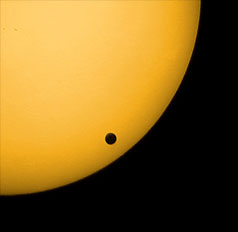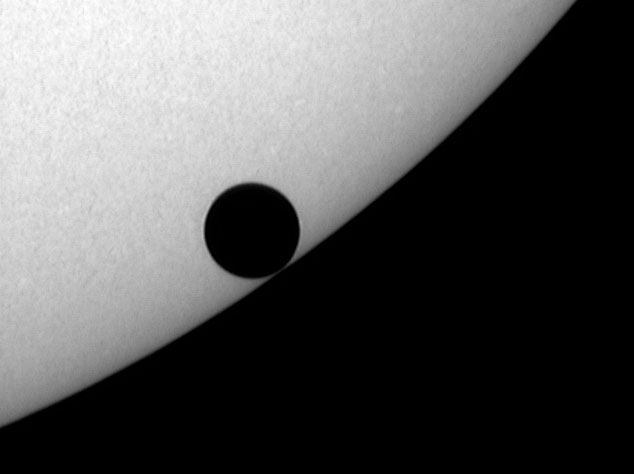

Note: Scroll down to view another picture and read my comments.

Comments - first picture only
Please note that the colours are "false". Although the image was acquired using a digital colour camera, my particular solar filter renders the Sun a rather neutral white, and for purely aesthetic reasons I chose to make the Sun look yellow. The image was given this particular hue, determined by my subjective mind, through computer software.
If you look carefully at the picture you'll find a slight darkening of the solar limb at the upper right and lower left. This is an effect of vignetting in the optical system and the darkening is not of solar origin.
An even closer examination reveals a couple of tiny sunspots close to the upper left corner.
Some technical notes - first picture only.
| Location | Lomma, Sweden, 13d East, 56d North |
| Optics | C8, stopped down to 60 mm aperture, with focal reducer/corrector. Camera afocally coupled to the telescope with a 26 mm Celestron Plössl eyepiece (Vixen-made "silver top") |
| Solar filter | Baader AstroSolar, 60 mm aperture |
| Mount | Vixen Super Polaris GEM tracking at sidereal rate |
| Imaging device | Olympus C2020 digital camera |
| Exposure time | 1/400 s |
| ISO setting | 100 |
| Post processing software | Photoshop |
Comments - second picture only
This is an attempt at catching the alleged black-drop effect that many observers claimed to have witnessed during earlier Venus transits. The picture is a composite of about 10-12 frames taken during a three-second interval at third contact (beginning of egress). The short story is that I found no evidence of the famous black drop, neither visually nor photographically. It seems that my conclusion is consistent with the majority of reports on the Internet. I will, however, monitor the discussions regarding this phenomenon.
Some technical notes - second picture only.
| Location | Lomma, Sweden, 13d East, 56d North |
| Optics | C8, stopped down to 60 mm aperture, prime focus |
| Solar filter | Baader AstroSolar, 60 mm aperture |
| Mount | Vixen Super Polaris GEM tracking at sidereal rate |
| Imaging device | Philips ToUcam Pro with Baader UV-IR cut filter |
| Exposure time | Information will hopefully be available soon |
| Imaging method | 10-12 (approximately) frames manually selected |
| Stacking software | Registax |
| Post processing | Photoshop |
Comments and suggestions are welcome. Send e-mail to bengt@df.lth.se
Images and text copyright © 2004 Bengt Ask.